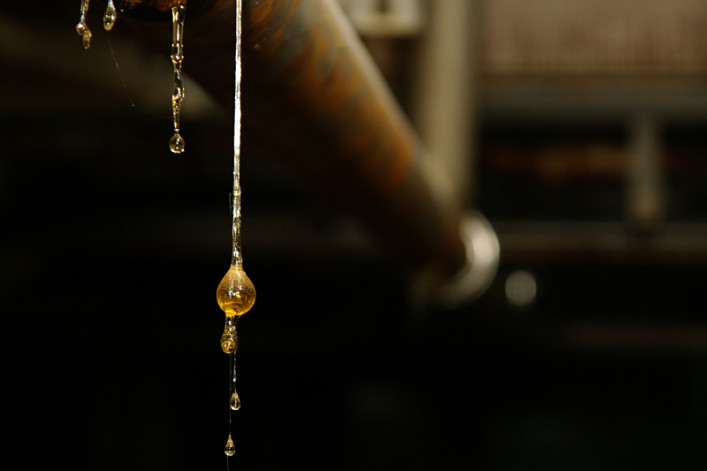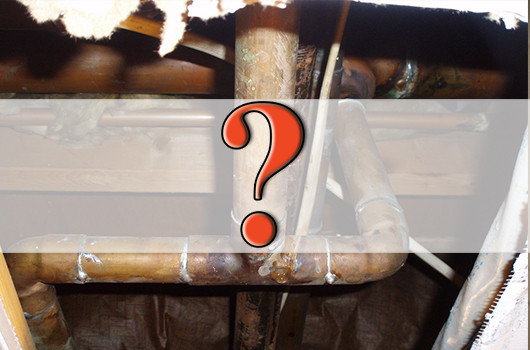4 common brownstone leaks—and how we (mostly) fixed them

Longtime New Yorkers Angela Tiffin and Andrew Nichols bought their first brownstone in South Park Slope in May 2012, and have spent years renovating—first, their own duplex apartment, then a third-floor rental unit—much of it on their own. You can read more about the project at their blog, Brownstone Cyclone.
[Editor's note: This story was first published in 2015.]
If this isn’t a proverb, it should be: as soon as you complete something during a renovation, something else goes wrong. When you’re dealing with a 100-year-old brownstone, it happens more often than not. And water is particularly destructive because the damage extends both to the thing leaking, as well as its surroundings—home insurance policies have a high deductible for water-related damage for a reason.
Here are four ways water can (and in our case did) damage a house:
1. The roof
We’d recently accomplished a lot in our top-floor rental unit, including installing kitchen cabinets, counters and appliances. We’d also just installed doors, casings, and moldings, and painted all the ceilings. This is where the proverb comes in: as soon as we finished the ceiling there was a big rain and sleet storm that revealed a (hopefully) small leak in the roof.

We had to cut around this light to let the water drain, and then peek into the ceiling in search of the leak.
A homeowner’s nightmare is a leaking roof in the winter because you need dry weather and above-freezing temperatures for repairs. Luckily, after a bit of investigating, we suspected that the water was coming in through a small tear in the roofing. We covered the tear in plastic and waited for the next bout of precipitation, and there was no leak. We were pretty sure we'd found the source.

Above, the tear in the roof membrane on the side of the parapet
What we need is a temporary fix until spring when we can assess the entire roof. Unfortunately, it’s been too cold and snowy to do anything. Last spring we repaired a similar tear in an old skylight. We used Karnak Flashing Cement and some cotton fabric:

Using a trowel, we spread the Karnak across the suspected leak and laid down the fabric across all the edges—this just gives it some strength. Then, we put more flashing cement over the tape, spreading it away from the edges like icing on a cake. Over time the flashing cement will get harder but never completely harden so it holds the seal while the building flexes between freeze and thaw cycles. This fix only set us back about $30.
2. The sewage line
Aside from the roof, this is a homeowner’s least preferred leak, and it always comes at the worst time—for us it was during the Christmas holidays when we were enjoying our new kittens, a surprise present for our daughter. We went down to the basement for some reason and discovered the sewage pipe leaking water all over the floor, luckily before it had damaged anything.
In most buildings, all of the sinks, showers and toilets drain down into a single four-inch or larger pipe, which runs out to the street and the city sewage pipes. If you clog a toilet, you’ll get water backing up (and possibly an overflow) in just that toilet. If you clog the building’s main sewage line, you’ll get water backing up into the lowest basin in the house—a toilet, bath or shower, depending on what floor everything is on. In our case, we have a special drain and one-way valve for our split AC system which, as it turns out, is the lowest point where the water could spill out. Sadly, this also meant it seeped onto the basement floor.

The water was coming out of the top of the U-shaped pipe with the split A/C drainage pipes on the left of the black one-way valve.
It seems the “flushable” kitty litter we had purchased was not so flushable after all. As DIY-ers, we tackled the problem ourselves. Nothing says “family time” like clearing sewage-filled pipes with your loved ones.
First, we wanted to stop more water accumulating on the floor, so we collected as much as possible coming out of the supposedly one-way valve and carted it in buckets out to the street. Once we had the water level low enough, we took off the valve and used our water pump (something all homeowners should have on hand), and things went much faster.

Above, the sewer line snake
Next we took a trip to the hardware store and purchased a 50-foot long sewer-line snake and pushed it through the opening previously inhabited by the one-way valve. We twisted it around a bunch and wiggled it back and forth in an attempt to find the clog but had no luck. This whole process took about three hours, and we were exhausted, so we reluctantly admitted defeat for the night.
The next day we called A&L Cesspool, a company that specializes in clog removal, and one of their plumbers arrived in 45 minutes. He was able to clear it in less than half an hour by feeding a 100-foot power snake through another opening, a clean-out trap that we’d been afraid to open because we thought a surge of sewage would come out. According to A&L, the main blockage culprits are flushable toilet cleaning pads, paper towels, hygiene products and, yes, some kitty litter. It only cost about $140, which is not bad. But now, having seen it done, we could easily do it ourselves next time.

Above, an ancient-looking clean-out trap the A&L Cesspool guys opened
We're also considering installing a leak alert system.
3. The appliances
When we told other brownstone owners who are also landlords that we planned to have a washer/dryer in our rental unit, they thought we were crazy. The more appliances you have, the more chance for leaks, they said. They were right.
We were using the washer/dryer for our own use (while we finish the rental for tenants), and a pipe came off the back of the washer and spilled all over the floor. We hadn’t yet installed the new floors—phew!—but the water did cause some minor stains on the ceiling of our owner’s duplex.
To prevent future leaks of this type we installed a pan and an OnSite Pro FloodStop for both the washer and the dishwasher. The FloodStop is a device with a water sensor and a couple of valves that shuts off the water if the sensor gets wet. With the pan under the washer and the FloodStop, we’ll hopefully be alerted to minor leaks before they can cause much damage.

Putting the washer in the floor pan should catch a relatively small leak.

The FloodStop auto shutoff valves.
4. The mystery water
Our final and most serious leak occurred recently in our bedroom. Since we’d contracted out the renovation for this part of the house, as soon as we found water dripping onto our floor and a wet spot on the ceiling, we called our contractor. He asked us to cut open the ceiling to see if we could identify the source of the leak. With a heavy heart and a plastic sheet over our bed, we sawed open a two-and-a-half-by-four-foot hole in the area that had the most water, and pulled out a lot of insulation.
We could clearly see that the subflooring of the terrace was soaked directly below the area where the exterior wall meets the terrace, and the nearby floor joints were damp. So we cleaned up our room and a few days later our contractor came by to take a look.

Above, wet subfloor and floor joists under our terrace
Of course, by the time he arrived, the outside temperature had dropped and any water on the terrace had frozen, thereby stopping the leak. Inside, it had mostly dried up, but the subflooring was still damp, so he could see some of the problem. Sadly, until it warms up there’s nothing much he can do. We just need to keep the snow and ice off the terrace so that it doesn’t melt through and in the spring we’ll do a few tests with the hose to see if we can locate the exact problem spot. Until then we just have to live with this in our bedroom. Yay!

Before taping this plastic over the hole, we put some of the insulation back in to keep our bedroom a bit warmer.
You Might Also Like


























